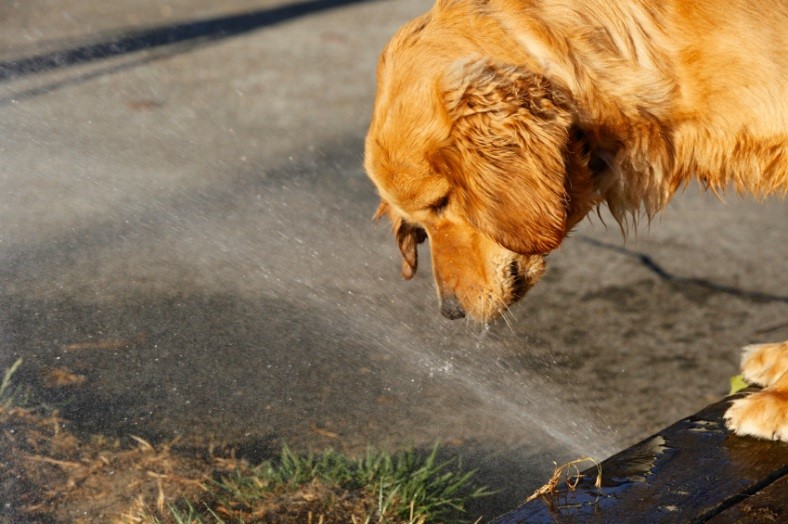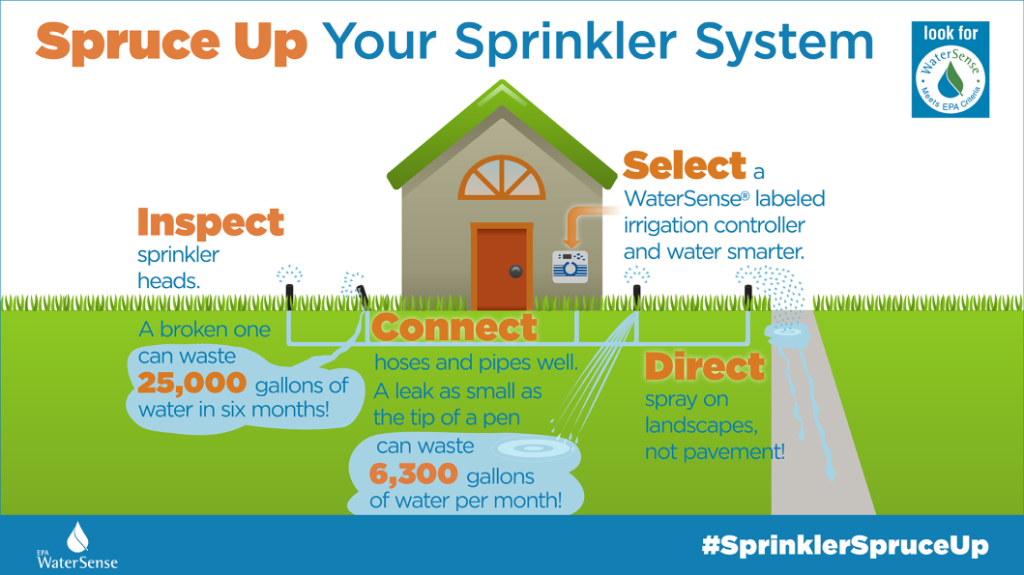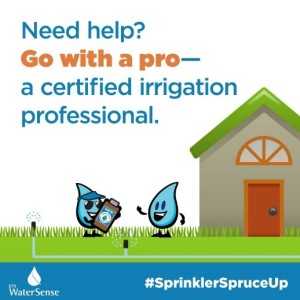
Written by Beth Livingston, U.S. Environmental Protection Agency
How often do you think about your sprinkler system?
When I lived in Florida, without a harsh winter that might damage the sprinklers, it never occurred to me to inspect the irrigation system until, of course, there was a problem.
I remember turning on the sprinklers and watching my dog Downey run across the grass to drink out of what I am sure she considered was the most wonderful water bowl ever—a broken, bubbling sprinkler head.
Or at other times, watching the sprinkler water the driveway or the main road into the neighborhood wondering who would like to run around in the sprinklers while dodging cars at the same time? When I realized that was not such a great idea, I then focused on fixing the problem.
I had no idea how much water was being wasted.
Or how much money I was spending watering the driveway and road.
EPA’s WaterSense program notes that a single broken or missing sprinkler head can waste up to 25,000 gallons of water and more than $90 over a six-month irrigation season. I’m sure the asphalt in summer enjoyed the cool down, but I’d prefer to water smarter and spend that money on my landscape.
I used to shake my head at my neighbors who’d turn on their sprinklers at noon, the hottest time of the day. It was so hot in the summer time (think eggs frying on the sidewalk), I’d be surprised if the landscape even got slightly damp. No wonder half of their water usage was going to outdoor water use!
I learned the best time to water was in the evening or early morning hours when I was assured my plants and grass would actually get the water they needed and not wither away.
We also had planted beds with local native plants that could withstand the Florida heat and humidity—this also provided the added benefit of watering less during the “cooler” months.

No matter where you live, the WaterSense program has four easy steps to help you do your own sprinkler spruce-up:
1. Inspect:
Check your system for clogged, broken, or missing sprinkler heads. Better yet, go with a pro—find an irrigation professional certified by a WaterSense labeled program to do the work for you.
2. Connect:
Examine points where the sprinkler heads connect to pipes/hoses. If water pools in your landscape or you have large soggy areas, you could have a leak in your system. A leak as small as the tip of a ballpoint pen (or 1/32nd of an inch) can waste about 6,300 gallons of water per month.
3. Direct:
Are you watering the driveway, house, or sidewalk instead of your yard? Redirect sprinklers to apply water only to the landscape.
4. Select:
An improperly scheduled irrigation controller can waste a lot of water and money. Update your system’s schedule with the seasons, or select a WaterSense labeled controller to take the guesswork out of scheduling.
Watch the Watersense video:
Going with a pro:
WaterSense also publishes a list of certified irrigation professionals for those of us who’d prefer not to get dirty or soaked trying to fix our sprinkler systems. These pros can also help you select a WaterSense labeled weather-based irrigation controller, which uses local climate data to provide only the water your plants need.
I think this is pretty neat, as Florida gets a lot of rain showers, and the irrigation controller uses local weather data to determine when to water. The WaterSense website has other great tips as well.
Now that you have the tools, get out there and check your irrigation system before you ramp up your watering this year. And while you’re at it, get your dog a new water bowl! Good luck!
If you share this, please tag #SprinklerSpruceUp!
What else you can do to save water…
Listen to this Green Divas What You Can Do episode about water conservation to learn more about saving water at home:
Listen to more from the What You Can Do series.
[dynamic-sidebar id=’Custom Widget 2′]
~Asst. Ed. Green Diva Christine | Images via EPA Watersense
DoloresB
September 1, 2015 at 9:41 am
I would have to agree that it’s surprising how much water is wasted. I’ll have to go through your tips to see if I can’t make sure that my water is being put to use all the way. That way I’m not wasting unnecessary water and money.